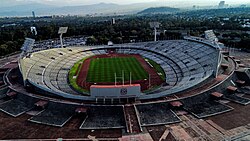University_Olympic_Stadium
Estadio Olímpico Universitario
Multipurpose stadium in University City, Mexico City
Estadio Olímpico Universitario is a multi-purpose stadium located inside Ciudad Universitaria in Mexico City. It was built in 1952 and at that time was the largest stadium in Mexico. This stadium has a capacity of 69,000.[2] The first major event held in the stadium was the 1955 Pan American Games. During the 1950s and the 1960s this stadium was used mostly for college American football matches between the largest Mexican public universities at the time: UNAM and IPN. From the late 1950s it was used for football matches, some American football matches and athletics. American architect Frank Lloyd Wright called it "the most important building in the modern America".[3][dubious ]
This article needs additional citations for verification. (December 2022) |
The Olímpico Universitario hosted the 1968 Summer Olympics; for the event the seating capacity was increased from 70,000 to 83,700 spectators (without substantially modifying the original structure) to cover the IOC requirements for an Olympic stadium.[4] It was the location of the track and field competitions, equestrian events, certain association football matches, the arrival of the marathon and the opening and closing ceremonies. This was the Olympics in which Tommie Smith and John Carlos protested the treatment of African Americans in the United States by performing a black power salute during the medal ceremony for the 200 metres (which occurred in this stadium). The stadium also hosted the track and field events at the 1975 Pan American Games.
The stadium hosted four games of the 1986 FIFA World Cup, but the final match was played in the bigger Estadio Azteca in Mexico City.
The Tartan track was the first All-weather running track to be used in the Olympics. Such a track is now a requirement.
During the second leg of the Liga MX final between Universidad Nacional and América, two hours before the start of the game, the building looked at its maximum capacity, but outside there was still a crowd of at least 30,000 more. At that time, Ciudad Universitaria did not have fences that surrounded it and it was easy to get to the access tunnels of the stadium. During the attempt of the fans to get to the pitch in one of the access tunnels (the tunnel number 29) a number of people got stuck and ended with the death of 11 people and several others injured.[5] [6] [7]
Currently, it is the home stadium of Universidad Nacional and American football team Pumas CU.
This sport facility is part of the Ciudad Universitaria ("University City"), the main campus of the UNAM.

